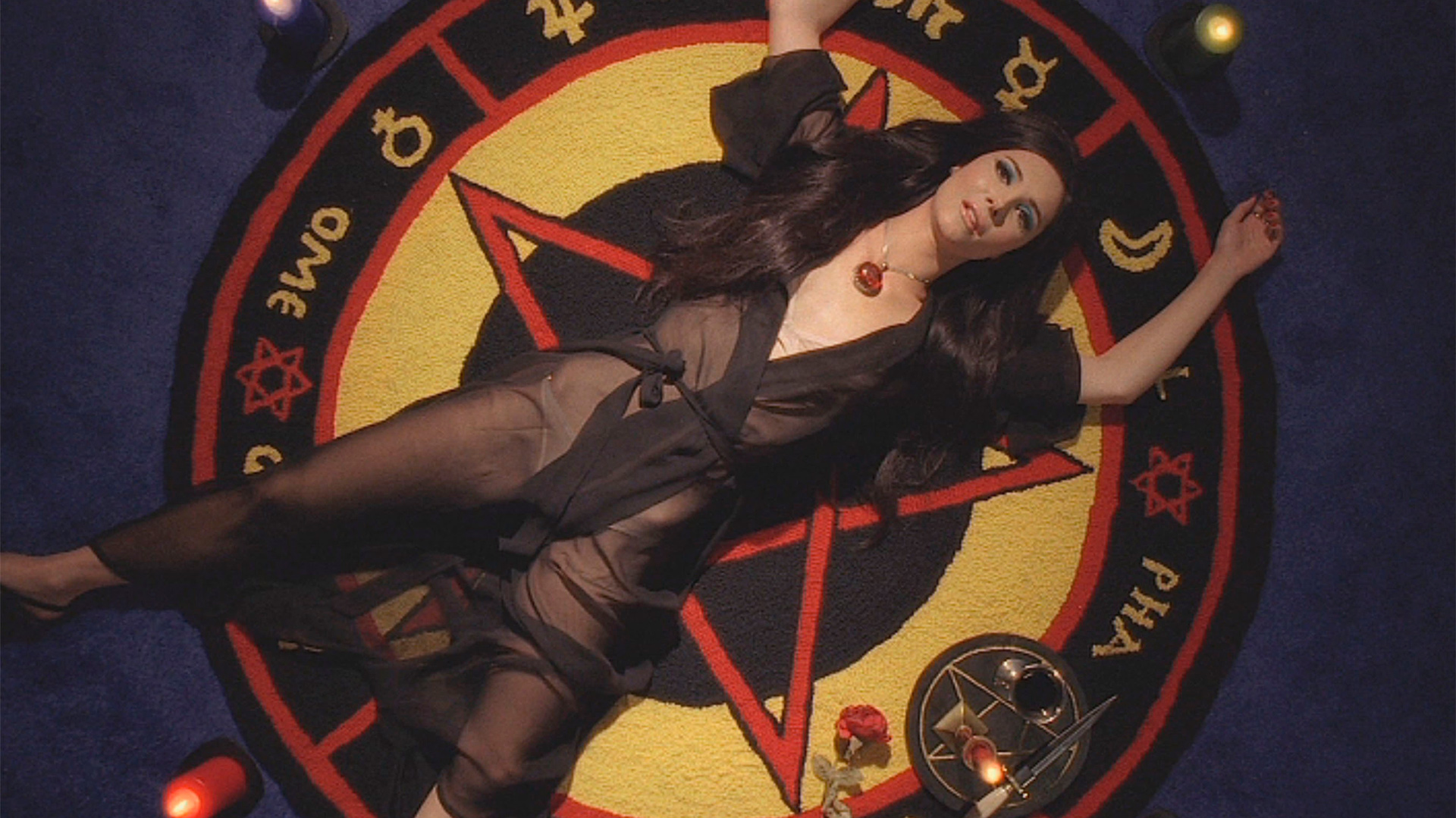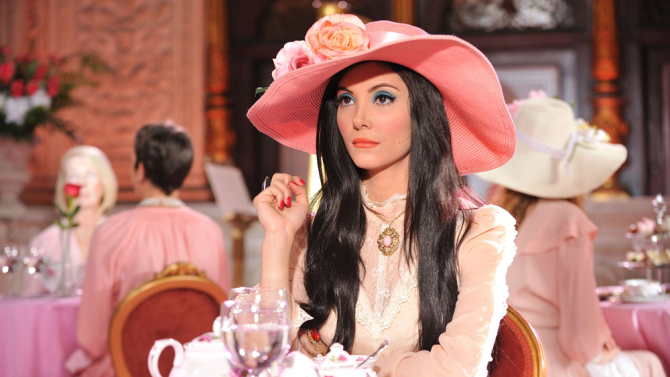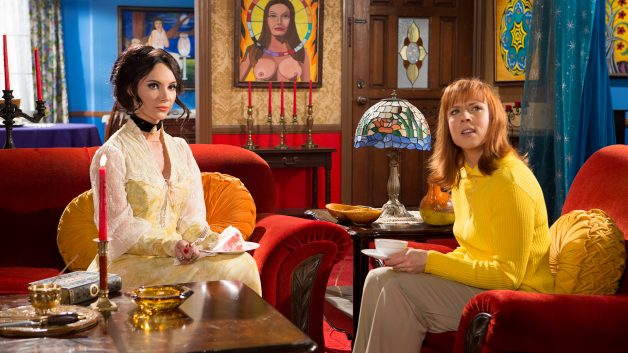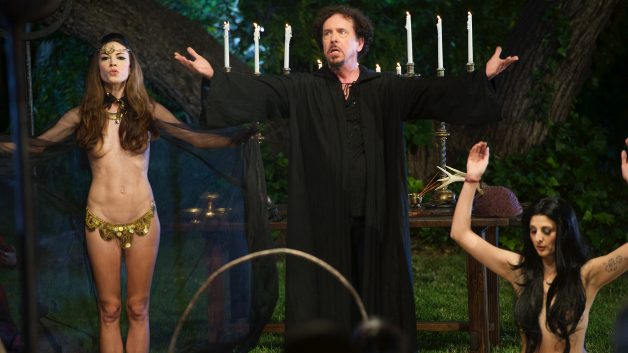It’s about time we had a horror-thriller about sex, sex magic, and the war of the sexes!
In Anna Biller’s fun and campy The Love Witch, the beautiful witch Elaine turns to magic to find someone to love her, only to discover tragically that things don’t work out quite as she envisioned them …or do they? The story is filmed in a style that meticulously recreates the look, feel, and melodrama of Technicolor thrillers of yore. Stylistic touchstones include Hitchcock, Italian horror, and classic horror B-movies. The contrast between the film’s modern themes and retro style makes The Love Witch an irresistible delight.
The titular character, played to full effect by Samantha Robinson, is a femme fatale for the ages, leaving viewers guessing whether she’s a lovelorn woman who simply wants to devote her existence to Mister Right, or a clever manipulatrix who uses her wiles to bend men to her pagan vision. As director Anna Biller explains, Elaine “is a totally ‘constructed’ woman, with layers of makeup, lashes, fetish lingerie, a wig, and Victorian costumes—all of which she hides behind and uses as a weapon. The witch is a very loaded female image, as she stands for both female power and the male fear of female sexuality. She is the female version of the serial killer: a woman who kills for love. She is pathologically narcissistic, and I try to show how the world looks to her from the inside.”
The movie’s striking visuals reflect incredible attention to lighting, costume, makeup, composition, and set design. It was even filmed in 35mm to help capture that saturated Technicolor look. The opening scene of Elaine driving is completed with vintage rear projection effects of the road behind her. When she arrives at her destination, emerging from her red mustang wearing a red dress and pulling her red luggage from the trunk, you get a sense of how much thought went into every shot. And that first Victorian tea room scene looks like it was filmed not in 2016 but in the era of Breakfast at Tiffany’s. The attention to detail leaps out in every frame.
Biller had a definite vision for this film, and was very hands-on throughout the production. “I made all of the renaissance costumes and a custom wardrobe for Elaine, plus a lot of the props, including a hand-hooked pentagram rug. I did hundreds of set and costume sketches and storyboards, made paintings and wrote period music, spent several years on the script, and worked for a year with my lead actress to develop the layers we needed in her character.” She also gave cinematographer M. David Mullen a stack of DVDs as visual references. To his credit, Mullen did a fantastic job of recreating the style of classic films from the 1950s through 1970s.
Speaking of attention to detail, attentive occultists will find plenty of Easter eggs to enjoy, too. The Rider Waite Tarot appears throughout, and Elaine’s apartment is decorated with artwork inspired by both that deck and the Thoth Tarot. We see an image of Baphomet. In a blink-and-you’ll-miss-it shot, her Book of Shadows begins with “Every man and every woman is a star.” If memory serves, an occult expert’s office has a large print of one of the plates from Francis Barrett’s The Magus, and he supports his claims by pointing to illustrations in Montague Summers’ Compendium Maleficarum. The film also offers glimpses of Gardnerian/Wiccan ceremonies, including the fivefold kiss, symbolic Great Rite, Charge of the Goddess, and the Witches’ chant “Eko Eko Azarak.”
These last two will be of particular interest to readers of this blog, as Gerald Gardner’s Charge of the Goddess originally borrowed a great deal of its language from Aleister Crowley’s Gnostic Mass (Gardner later revised the language to make it less obvious). And the Witches’ chant from the Gardnerian Book of Shadows is copied and elaborated upon from a 1921 article on “The Black Arts” by Crowley compatriot J.F.C. Fuller.
The result is an entertaining movie that could be viewed at multiple levels: It is a hilarious send-up of cheesy occult b-movies and the femme fatale trope. It is a cinematic homage to Technicolor thrillers of yesteryear. And it is a feminist statement about gender, power, and societal expectations. And it succeeds on all levels.
The Love Witch is completing a limited run in selected art houses and theaters across the nation, and will be available digitally on April 1, 2017. For more information, see http://thelovewitch.oscilloscope.net/.
Writer, Director, Producer, Editor, Production & Costume Designer: Anna Biller
Distributed by Oscilliscope Laboratories
Running time: 120 minutes




